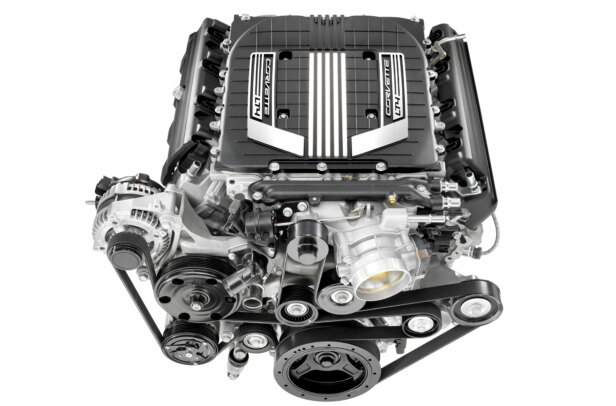Packing 670hp, the new Chevrolet C8 Corvette Z06 houses the world’s most powerful naturally-aspirated V8.
Because it is a radical step away from what we’re used to seeing from GM, we decided to take a deep dive into it in preparation for when it eventually winds up as a crate motor.
The previous record was held by the Mercedes-AMG M159, a 622hp (464kW) 6.2-litre from the hot-sauce SLS Black, but Chevrolet thoroughly stomped this with the LT6. How’s about 670hp (499kW) at 8400rpm from a 5.5-litre eight-pot screamer?
Don’t think you’ll be swapping LT6 parts into your 5.7 LS1 – it has actually seen use in the C8.R GT3 racing Corvettes.
It may feature an LT-series RPO code like the pushrod LT1, LT4 and LT5 V8s, but this NA screamer is an all-new platform. We’re talking a thoroughly modern design with aluminium block and heads, double overhead-cam heads and 32 valves (four per cylinder), an advanced oil system, and direct-injection.
It runs the traditional Chevy 4.4-inch bore spacing, but the 104.3mm bore by 80mm stroke is a key aspect to its ability to bring all the arpees to the party. The flat-plane crank architecture doesn’t need counterweights, massively helping lighten the reciprocating mass, along with the short-skirt forged aluminium pistons and titanium rods, and an aluminium balancer.
With nearly 9000rpm on tap, you know the 9.5-litre-capacity oil system of the LT6 has to be class-leading, using race-style dry sump tech. Each cylinder is sealed from the rest to minimise pumping losses, with a six-section oil pump scavenging the dirty air out of the crankcase as well as the cylinder heads.
Those heads are modern four-valve per cylinder, chain-driven double-overhead cam per-bank castings using high-end finger-followers. The heads use titanium intake valves and sodium-filled valves on the exhaust, while the mechanical lifters and valvetrain (including dual-valve springs) feature such tight tolerances GM claims no adjustment is needed over the life of the engine.
While the LT6 runs direct-injection as per all fifth-generation small-block V8s, the injectors have been side-mounted. Taking inspiration from Chevrolet’s experience in IndyCar, the LT6’s injectors sit under the exhaust valves, as this improves the mixing of the fuel and clears space in the valley for the trick intake. While most DI engines mount the squirters under the intake valves because it keeps them cooler, it does compromise intake runner design, and the LT6 has water jackets surrounding its ones.
The intake manifold boasts a huge 11-litres of capacity and is fed by two 87mm throttle bodies. To put the LT6’s appetite for atmosphere in perspective, the 650hp supercharged C7 Z06 Corvette rocked only one 87mm throttle body.
The flat-plane crank fires cylinders in sequence on opposing banks, unlike a cross-plane crank. The GM engineers fitted three valves between the two plenums to use the Helmholtz resonance effect to cram more air into each cylinder on the intake stroke.
Boffins say when the intake valves close it causes a pressure wave that travels back up the inlet tract, and the valves between plenums allows this fast-moving air to help ram extra atmosphere into the cylinder about to fire. They’re using waste air in resonance supercharging to maximise the amount of air hitting each combustion chamber to enhance power output.
As the valves open in stages between 2000 and 5800rpm, the LT6 has a volumetric efficiency higher than 100 per cent. This is a big deal for engine nerds, because the LT6 inhales a greater amount of air than the static cylinder capacity.
Packaging is a huge issue with mid-engined big-bangers like the C8 Z06, as the swooping headers show. This has also meant the alternator and starter have to live in the valley.
Finally, keen eyes will spot the little rocketships cast or moulded into the engine, which is due to the LT6’s ‘Gemini’ codename (like the US space program).



Comments